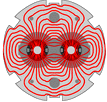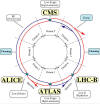The challenge |
The nominal LHC beam contains an unprecedented stored energy of 350 MJ, contained in 2808 bunches with a beam sigma of the order of 0.3 mm.
The extremely high destructive power of such a beam imposes an external dump, where the beam must be extracted completely from the LHC, diluted to reduce the peak energy density and then absorbed in a dedicated system.
|
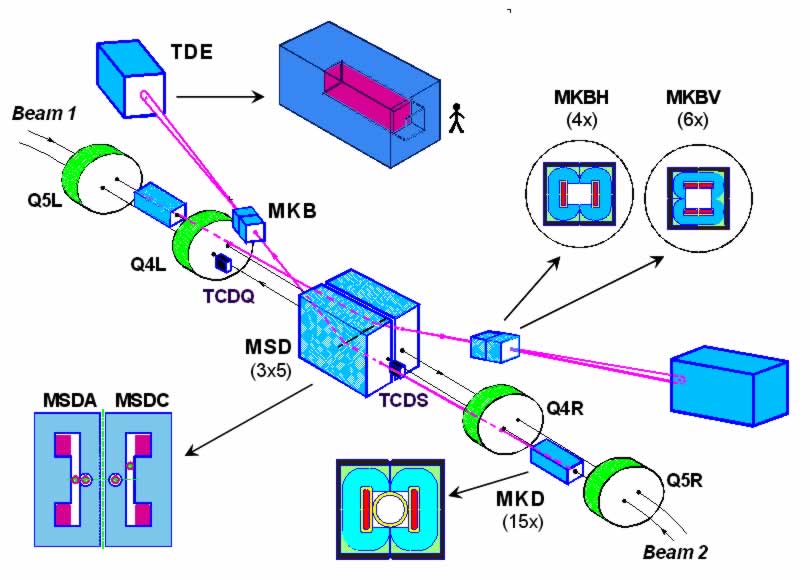 |
| Location |
Point 6 of the LHC is devoted to the Beam Dumping System.
New infrastructure includes junction chamber UJ62/UJ68, transfer tunnels TD62/TD68, dump caverns UD62/UD68 and personnel access galleries UP62/UP68.
|
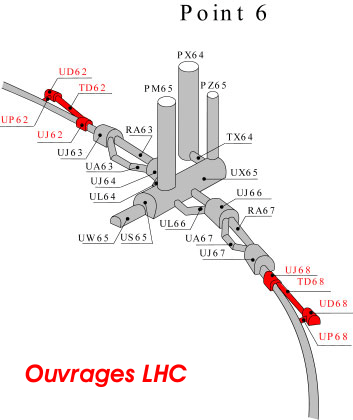 |
Extraction |
A gap of 3 microseconds in the circulating bunch pattern is present to allow the horizontally deflecting extraction kickers (MKD) to switch on.
15 MKD magnets are used to produce a total angle of about 0.27 mrad at 7TeV.
The entire beam is brought into the gap of a vertically deflecting Lambertson septum magnet (MSD). 15 such units produce a vertical deflection upwards of 2.4mrad for both beams.
 |
Dilution |
The extracted beam is swept in a quasi-circular figure by two sets of orthoganally deflecting dilution kickers (MKB), of which there are 4 horizontal and 6 vertical per beam. The subsequent 600m drift distance to the dump proper means that this figure has a circumference of about 120cm when the beam strikes the absorber, and the beam size has increased to an extent where the sigma is 1.6mm in both planes.
|
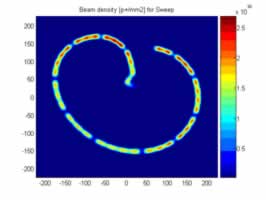 |
Absorption |
Each beam dump absorber consists of a 7m long segmented carbon cylinder of 700mm diameter, contained in a steel cylinder, comprising the dump core (TDE). This is water cooled, and surrounded by about 750 tonnes of concrete and iron shielding. The dump is housed in a dedicated cavern (UD) at the end of the transfer tunnels (TD).
 |
| Protection |
Internal or external faults could lead to an asynchronous beam dump, where the extraction kicker field switch-on is not synchronised with the abort gap. Dedicated dilution devices (TCDS, TCDQ) will be placed in front of the extraction septum and the Q4 quadrupole to prevent local equipment damage in the event of such a fault, and also to prevent bunches with large excursions from causing damage where aperture is restricted, notably the arcs at 450GeV, and the collimators and low-beta insertions around the LHC experiments at 7TeV.
|
The project |
The effort to finalised the design, build, commission and operate the challenging LHC Beam Dumping System involves a number of different divisions and groups at CERN. The LHC Beam Dumping System project was set up in January 2003 to coordinate all activities concerning this system. The LHC Beam Dumping System (LDBS) will be constructed from equipment designed and supplied by various groups in AB and AT divisions, and will also rely on the provision of infrastructure and services from ST and EST divisions. Technical coordination of the activities is necessary to ensure that baseline performance and scheduling are respected, to facilitate the construction, installation and commissioning phases and to provide an interface to the LHC Project management. These coordination activities are organised in the framework of the LBDS Project, which interacts closely with (among others) the MPWG, CWG, LHC-OP and LTC. |
